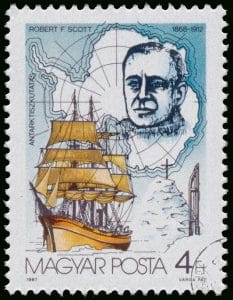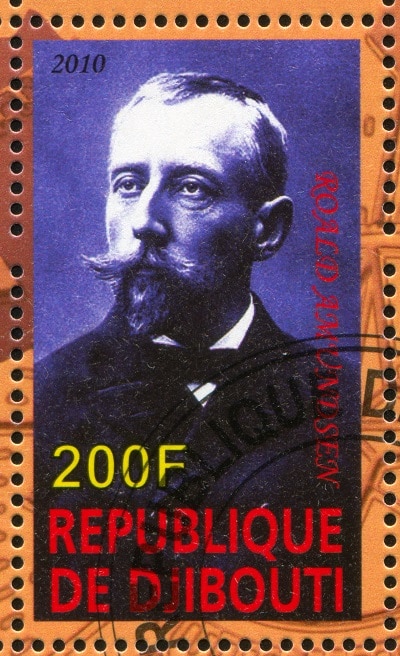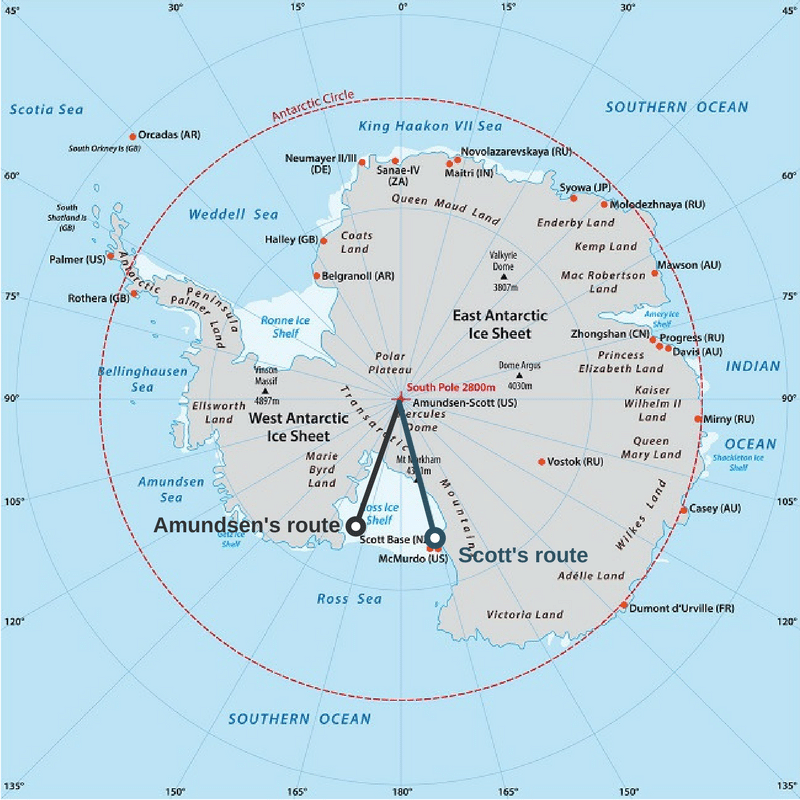Make Your Own Luck – Lessons From the Race to the South Pole
In 1900, no one had set foot at the North or South Pole - although many had died trying. At that point, it was seen as a tremendous feat of bravery and exploration to survive the extreme temperatures necessary to make it to the end of the earth. Early in the 20th century, several people made valiant runs at each pole: in 1902, the British Discovery Expedition made it into the heart of Antarctica but fell quite short of the pole. Ernest Shackleton made it within 112 miles of the South Pole in 1907. Frederick Cook and Robert Peary each claimed to reach the North Pole in 1908 and 1909, respectively.
The Competitors

The race was followed by the world, as illustrated by this stamp printed by Hungary, showing a depiction of Robert F Scott and his journey to the South Pole.
As of 1910, the title of first to reach the South Pole was up for grabs, and coincidentally, two explorers set out to reach it at nearly the same time. The two competitors were Robert Falcon Scott, a British Royal Navy Officer and veteran of the Discovery Expedition and Roald Amundsen, a Norwegian fisherman and explorer who was the first to make it through Canada's Northwest Passage in 1907.
Scott was considered a hero in Britain and his departure on June 15, 1910, received much fanfare. Many thought he was destined to become the first to reach the Pole.
Amundsen was well known from his voyage through Canada, but he had always had his heart set on reaching the North Pole. He and his group of 18 men set out on August 9, 1910, for what they thought (and had told everyone else) was a voyage to the North Pole. It wasn't until September, at a stop in Madeira, that he informed the crew they were actually going to the South Pole. He sent a telegram to Scott at this point - it was a surprise to Scott that he was going to have competition.
Scott set up camp on Ross Island in early October 1910 to spend the Antarctic summer preparing for his journey the next summer. He had chosen a course to the South Pole that mimicked the Shackleton journey a few years prior. Amundsen chose a different starting point - a yet untested location called the Bay of Whales. It was 60 miles closer to the pole, but there was fear that the bay would freeze over in the winter. Amundsen had read previous tails of other travelers in that area that convinced him it would work.
Their Plans
Scott's plan was to set off from Ross Island, 700 miles from the Pole, in late October with a crew of 16 men, 23 dogs, 10 Manchurian ponies and 13 sleds, including 2 motorized sleds. He would set up 10 "depots" along the way where he'd set down food, clothing, and tents for supplies on the way back. Along the way, he was planning to conduct meteorological research to bring data back to Britain.
Amundsen's plan was to set off from the Bay of Whales, 640 miles from the Pole, as early as possible after the sun arises in Antarctica (the sun rises and sets just once per year in the South Pole). He was concerned about Scott's motorized sleds and how that might give him an advantage. His traveling party was going to include 5 men, 52 dogs and 4 sleds with the plan to set up 7 depots at each of the "parallels" so they would be a consistent distance apart.
And They're Off...
Amundsen was the first to depart his base camp - he made an aborted attempt to leave for the Pole in September, but it was still too cold to make it very far. He regrouped and officially set out on October 20, 1911.
Scott sent his motorized sleds out on October 24 and the rest of the crew joined in departing on November 1, 1911.
Approaching the Glacier
Amundsen's goal with his departure point was to maximize his time on the Ross Ice Shelf - a level surface of barrier ice that made it easier to traverse. That left him with an uncharted path once he reached the continent of Antarctica as he'd have to climb a glacier of 10,000 ft to reach the elevation of the mainland and ultimately the Pole. Scott, conversely, spent less time on the Ice Shelf but was able to more quickly maneuver through the already-explored Beardmore Glacier to reach his destination.
Amundsen struggled mightily to find a good path through the glacier and ended up losing many of his dogs and sacrificing others to lessen his load as he made the very steep climb.
So Who Won?
Roald Amundsen's crew who arrived at the South Pole on December 14, 1911. Upon reaching the Pole, Amundsen said:
"Never has a man achieved a goal so diametrically opposed to his wishes. The area around the North Pole - devil take it - had fascinated me since childhood, and now here I was at the South Pole. Could anything be more crazy?"
For his part, Scott reached the Pole as well. He and his team arrived on January 17, 1912. Upon his arrival, he found a tent with a Norwegian flag and a letter address to the King of Norway that he was politely asked to send on should Amundsen's crew not make it back. Upon reaching the Pole, Scott said:
"This is an awful place and terrible enough for us to have laboured to it without the reward of priority."
He did, however, take solace in the fact that if he could return to camp ahead of Amundsen, he could share the news of his arrival at the Pole first, and receive the notoriety that would come with it.
The Long Road Back

Both explorers are still celebrated today shown by this commemorative stamp printed in 2010 featuring Roald Amundsen.
When you climb Mt. Everest and reach the peak, you still have to come back down - similarly, when you reach the South Pole, you still have a 600+ mile journey back to the edge of Antarctica. Amundsen had done a meticulous job of planting black flags every 3 miles so he could easily retrace his steps. He placed depots at strategic locations throughout the journey and his march back to camp was very efficient. He reached the Bay of Whales precisely on schedule on January 25, 1912.
Scott's crew made good progress over the first 3 weeks on the way back but then he started to run into trouble - one member of the crew was stricken with frostbite and another passed away on Feb 17. To add to that, he had expected a party to come assist him on the journey back across the Ice Shelf, but they hadn't arrived. He experienced a drop in temperature and his erratic strategy regarding his depots left him with long stretches to survive on limited food and supplies. His biggest problem turned out to be that he had set up his largest depot, called the One Ton Depot, 30 miles closer to the base than he intended as he faced storms in the initial plotting of the location and didn't want to press through them to the original, intended location.
Scott's Fate
All of the above factors played a role in Scott's ultimate demise. On March 29, 1912, Scott recorded the last entry in his diary - and he and his crew died of starvation the next day.
Breaking Down the Two Approaches
I find it extremely interesting to be able to compare and contrast the two approaches to figure out what made Amundsen so successful. Both parties took chances on the journey but ultimately, Amundsen was much more intentional in his planning which led to his superior execution. Let's compare and contrast the approaches:
Animals
- Amundsen used dogs that had been trained for these weather conditions. Scott experimented with Manchurian ponies, who, while quite strong, were not made for Antarctic temperatures. They all ended up dying in the first two weeks of the journey. Interestingly enough, Scott had sent a dog expert to China to secure these ponies.
Sleds
- Amundsen was concerned about Scott's motorized sleds, but they too had not been tested in this climate. They didn't last a week. Amundsen hired craftsmen to optimize his sleds for maximum speed and minimum weight, allowing him to move further every day.
Hauling
- Amundsen used the dogs to haul his sleds where Scott had planned to use ponies or motors to haul his sleds which carried significantly more weight. When they didn't work, he ended up "man-hauling" his sleds - so his crew would spend 9 hours a day dragging these sleds over wintery, mountainous terrain.
Depots
- The summer prior to his departure, Amundsen set out his depots strategically and supplied them with food that would last the winter, thereby allowing him to lessen his load. Scott set his depots out just before his departure and didn't plan that well - as noted above, if he had set the One Ton Depot out at its original location, he would likely have survived the journey
Clothing
- Amundsen spent years during his Northwest Passage journey living with Eskimos in Northern Canada, learning the value of using animal skins as they were the lightest weight, warmest and most moisture-resistant clothing to wear in extreme temperatures.
Rhythm
- Amundsen's plan was to move 5 to 6 hours per day to keep his team fresh for the long journey. Scott's plan varied based on weather conditions and he often pressed on for 9 hours per day, exhausting his crew and increasing the need for food to replenish their strength from man-hauling these sleds.
Lessons from the Race
I'm not the first to write this historical race, but I want to hit on a few key lessons I took away from researching this:
- Don't send a dog expert to get ponies - put your team in a position to be successful. Don't send a team member off on a brand-new experience and expect outstanding results.
- Don't run motorized sledges in the cold - I equate this to putting newly-developed code straight into production. Test out a new idea in its environment before you anoint it as the ultimate solution.
Don't just follow an established route - just because something's been done before doesn't make it the best possible way. Do your research and determine if a better way exists. - Set black flags along your route - document your path so you can retrace it the next time you need to do the same thing. It's amazing how much more quickly you can do something the second time with documentation than having to reinvent the wheel.
- Go live with the Eskimos - you can learn a lot from the experts. Go seek their advice and take the best ideas they can give you. Trying to figure out something complex on your own is often not the best path to success.
Closing Thoughts on the Race to the South Pole
If I could go back in time and do anything in history, I would have been an explorer. I love the challenge of discovery and dealing with the adversity that comes along the way. It's funny, shortly after the South Pole discovery, it was Scott who was hailed for his bravery. Amundsen was considered "cold and calculated" and therefore not celebrated as much. Looking at it 100 years into the future, I'd rather be "cold and calculated" and alive, than buried in Antarctica. I'll leave you with this quote from Amundsen that I found compelling - reinforcing my belief that you make your own luck:
“I may say that this is the greatest factor—the way in which the expedition is equipped—the way in which every difficulty is foreseen, and precautions taken for meeting or avoiding it. Victory awaits him who has everything in order — luck, people call it. Defeat is certain for him who has neglected to take the necessary precautions in time; this is called bad luck.”
Footnote: the information for my Stoneridge Connect, client conference keynote and this post came from a variety of sources including Jim Collins "Great by Choice", various Wikipedia pages, and this article.
Under the terms of this license, you are authorized to share and redistribute the content across various mediums, subject to adherence to the specified conditions: you must provide proper attribution to Stoneridge as the original creator in a manner that does not imply their endorsement of your use, the material is to be utilized solely for non-commercial purposes, and alterations, modifications, or derivative works based on the original material are strictly prohibited.
Responsibility rests with the licensee to ensure that their use of the material does not violate any other rights.

